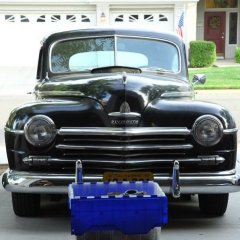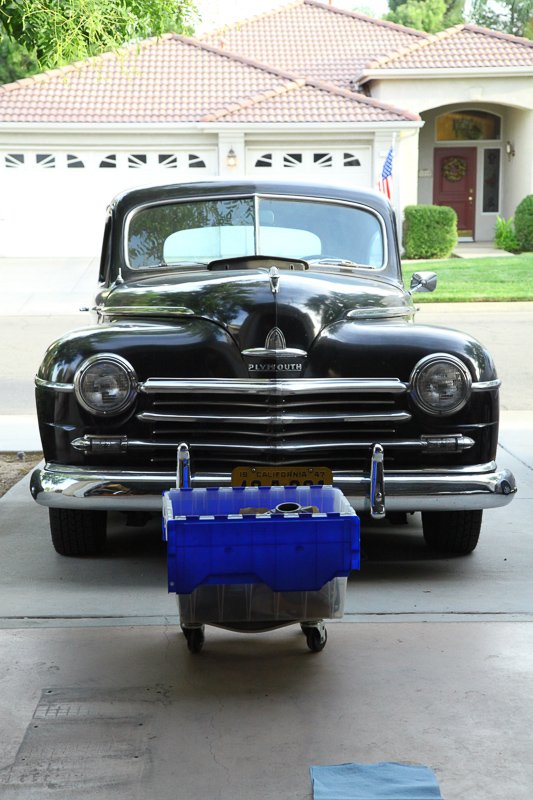-
Posts
289 -
Joined
-
Last visited
-
Days Won
2
Content Type
Links Directory
Profiles
Articles
Forums
Downloads
Store
Gallery
Blogs
Events
Everything posted by Mark Haymond
-
These flathead six engines are easy to work on and have a good reputation for reliability. That's their charm, a 60 year old engine that can still be a daily driver. My advice would be to install a single MAGNAFLOW muffler which will give a pleasing engine burble at idle but will run quietly on the highway. A FLOWMASTER, a different muffler, on the other hand, is loud all the time and can make it hard to hear conversations at highway speeds.
-
Tuff Stuff. Walmart. Good tip, thanks for sharing.
-
Nice camera work.
-
Enjoy your new ride.
-
Perhaps a head gasket leak allowed oil blow by from weak rings in cylinders 3 and 4 to slowly get into the water passages in the head. High pressure pushed oil into the low pressure cooling system. Low pressure coolant could not come the other way, not against 85 PSI. This leakage may be a secondary problem with the engine. I can not explain how this leak would cause so much power loss after going uphill under load for a while. Still a mystery.
-
Exciting times for sure, after 12 years. You mentioned the drive shaft. Remember the parking brake only grabs the drum on the back of the transmission, it does not connect to the axle or wheels. I was under my P-15 on a slightly inclined driveway when I unhooked the drive line. The car slowly started drifting down hill and I had time to scoot out sideways, then watched as it drifted into the street where it stopped on its own. I just want to help you get to those first magic driving experiences.
-
I do not know the solution but here is something to check. 1. If you take off a shoe and lay it inside of your drum, does the curve off the shoe match the curve of the drum? 2. On another thread cars owners have encountered different length forked pins that come out of the brake cylinders and push against the brake shoe. A longer pin will not let the shoes retract enough to get the hub on.
-
The curved glass is plenty strong. I wrecked a 50 in my youth. During the roll over the rear glass popped out in one piece. At the local junk yard I threw my glass from above my head down onto a concrete block. Why do boys do this stuff? It bounced off a couple of times without breaking so I gave up.
-
I replaced the rubber seal in my 50 Plymouth, a curved one just like your 49. I believe I used one from Steelrubber. Using the 46-54 service manual, the install went OK, and easier for me than the front glass. I wish I had used a recommended silicone seal between the rubber and the metal body steel because I had to reseal and reseal a few times to get mine rainproof. If you have not installed a headliner yet, this is the time to use a water hose and make sure there are no leaks from the window OR the fasteners of the stainless belt line molding on the back of the car. Letting it sit out in the rain was a better test than a quick water hose check. Now that it is all sealed I enjoy driving in the rain and feeling warm and snug inside.
-

New To Forum - 1951 Plymouth Cambridge Club Coupe
Mark Haymond replied to 51CamClub's topic in P15-D24 Forum
It is a nice 51. Welcome. -
Yes, yikes. I never imagined there would be TWO stock fan failures among the members of this forum, but there they are, plain as day. I can only share the pain with this cell phone photo of my car leaking its coolant after my electronic fan control failed in the Starbucks drive through lane. http://www.smugmug.com/gallery/n-BtgMz/i-h6vxcK9
-
1941Rick, Yup a four bladed fan will be more authentic and more reliable than the electric fan, electronic thermostat, relay, and temperature sensor. But oh wow, the new setup lets the motor run more quietly and there is no fan noise above 25 mph. I pretend it is a 1947 Plymouth factory option like turn signals and radio. Don, I am actually running a seven pound radiator cap, MCS 7007. I had to cut the beads off my inlet and outlet. I have a minor leak but it is from one of the thermostat housing bolts. I need to remove it an apply a generous amount of sealer to it. I look forward to Don's next road trip post when he will have...no...temperature problems...really...to...report.
-
The body looks solid. It has waited for you all these years, so be patient in bringing her back to life. You will enjoy the new learning curve.
-
Had the same problem with my P15 suspension. I lubed the upper and lower A arm with a grease gun on the zerk fittings with only partial success. I noticed some zerk fittings just did not want to accept much grease. A few days later I selectively sprayed the heck out of certain joints with WD40 to narrow down my search. I ended up disassembling, cleaning, and reassembling the passenger side front suspension. No new parts were used. The noise was caused by bushings that were dry steel on steel contact and the lub could not reach the moving parts. That fixed my front. So maybe your lub also did not get to where it needed to reach. (My rear spring bushings still squeak. They are probably the originals and I need to replace them with new parts.)
-

The Phoenix is awakening / B3B Rises from the Ashes
Mark Haymond replied to pflaming's topic in Mopar Flathead Truck Forum
I seem to remember.....the car steering wheel has a splined hole but there is a subtle flat spot in the hole that keys to a similar feature on the steering shaft. Of course if the diameter of the truck and car parts are different they just won't fit together. -
Yeah, go for it. Try to get the flathead into the hands of someone who can use it for their car. That will make two drivers happy.
-
Yeah, the rod simply rubs on the hump. It won't rattle. And when you slide the seat forward the seat moves but the seat tracks and the rod stays in the same position.
-
I had a 50 Plymouth radiator repaired with a new core. It was a little pricey, about $380 ten years ago. With a flushed out block and the repaired radiator the car has never overheated, even on 105 degree days in Fresno. More recently, I put a new aluminum radiator in my 47 Plymouth because it was cheaper and I did not care if it looked stock or not. Caution: the aluminum ones are soft and the cooling fins will become dented with casual handling, contact with knuckles or tools, or fan belt tightening near them. Count yourself talented if you can install one without a few dents in the fins. Now that it is in, it also works just fine on hot days.
-
Like Dodgeb4ya, the square end of a 1/2 wrench got mine off. Nothing else I had would grip the corners effectively. I made a cork gasket and tightened the plug, but it had a slow leak. On my second try I made another cork gasket and used red silicone sealer on both sides of the gasket. That stopped the leak.
-
If you get the rear end from the donor car your 41 Plymouth will think it is an 86 New Yorker. Besides running reliably it will be the right gear ratio and strengh, and it will greatly simplify ordering repair parts. Just tell the parts supplier you need brakes, tune up parts, or an alternator for an 86 New Yorker and they can source it for you. Get the power steering pump and air conditioner compressor included with the engine in case you decide to use them some time in the future. A drive shaft can be fabricated or modified by a driveline specialty shop for a surprisingly low cost. They often service the trucking and agriculture industry. Get the uncut parking brake cables with the rear end so you can rig up your parking brake.
-
Perhaps you could carry a load with the tailgate down, and the hinged plate would swing down and be visible to comply with motor vehicle rules. I am just guessing.
-
Dick41, I have an old 318 LA with a 904 automatic tranny in my 47 Plymouth and love the setup because it is so easy to drive and so reliable. I have had plenty of manual transmission cars and do not miss the shifting at all. You are not going to save money by choosing the V8 route. It will cost you 50% or 100% more than you think because...it will be a street rod project....nothing will fit easily...everything will have to be moved or modified a little...it will take months and months and months. But it can be a great Mopar learning experience and if you do it right you will have a ride that is a pleasure to drive. Yeah, it can be worth it.
-
Like blueskies said. My 1950 Plymouth has the armored cable too which runs from the back of the ignition switch and goes through the firewall. The armored part sticks out into the engine compartment about an inch. It makes it difficult to jump power to the coil from inside the car. Like blueskies I took the tedious route and opened up the ignition switch. A dremel tool came in handy. I soldered in a brand new wire and re used the armored cable. It has worked OK the last ten years.
-
After seeing this steering I would want to pull some drums and check the brakes.
-
Could not find my eraser shield, it is around here somewhere. But I have had occasion to use my instruments on various projects over the years. My goodness, they last a lifetime. http://www.smugmug.com/gallery/n-LvGkD/i-3p7pFwd
- 386 replies


